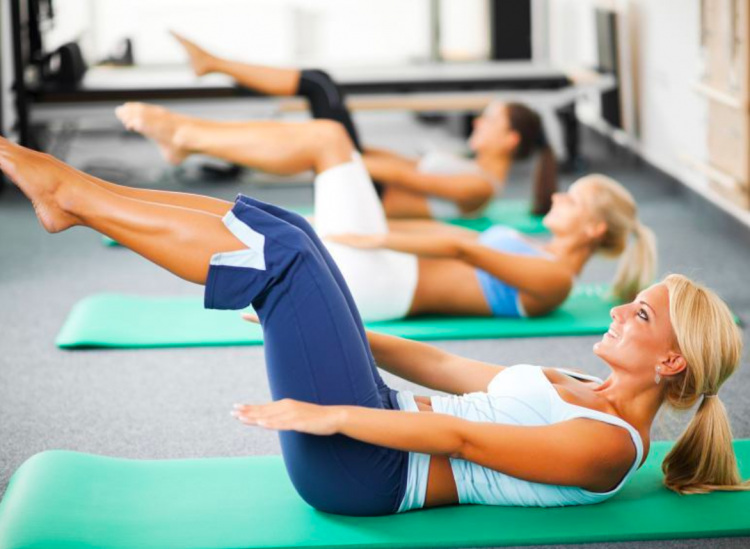8 Terms You Need To Know Before Going To Your First Pilates Mat Class

@physio_imago
If you want to give your core some TLC, Pilates is one of best workouts to try. Its clear focus on breathing, muscle activation and slow, controlled movement helps you work your abs, obliques, lower back and glute muscles like no other fitness class. With that said, the vocabulary used by Pilates instructors is equally unique. So to avoid any confusion and keep your first Pilates experience as positive as possible, check out the following eight terms you’ll most definitely hear while lying on your mat for those surprisingly intense 45 minutes. You’ll be a Pilates mat pro in no time.
1. Powerhouse
Your “powerhouse” is the center of your body just below your belly button where the majority of your core strength is derived. You need to engage your powerhouse — lower abs, lower back, pelvic floor and glutes — to execute any movement in Pilates correctly.
2. Neutral Spine
The human spine has a natural curvature extending from the base of the head all the way down to the tailbone. So, when lying on the floor, if you’re “maintaining a neutral spine,” different sections of your spine should be slightly lifted away from the mat. While each person’s spinal curvature varies, it’s typical for the middle of the cervical spine (your neck) and the lumbar spine (your lower back) to maintain enough of an arch so that your hand could slide into those spaces beneath you.
3. C-Curve Spine
The C-curve spine cue is used for a lot of lower abdominal exercises. In this position, you’re intentionally pressing your lumbar spine (or lower back) into the mat so that the entire front side of your core can activate correctly while the back side of your body stretches. This usually means that your head and shoulders will come off the mat slightly as well so you don’t strain your neck. From the side, your spine creates a “C’ shape in this position.
4. Pelvic Floor
The pelvic floor consists of a set of internal muscles that are most commonly activated when you need to go to the bathroom but have to wait for access to a restroom. (Cute, we know.) Pilates instructors often cue students to “engage the pelvic floor” when executing exercises like glute bridges and leg extensions so the lower part of the “powerhouse” stays strong and the lower body remains in proper alignment. Internal muscles need strengthening just as much as external ones, apparently.
5. Headlights
“Headlights” is just a fun way of identifying the frontal points of your hip bones and keeping you mindful of their alignment through various exercises that require leg lifts and rotational movements of any kind. You can easily locate the bony, knobby part of the front of your pelvis by placing your hands on your hips and palpating with your pointer and middle fingers. From there, when told to “make sure your headlights are still facing the mirror,” you can focus on the proper alignment of your hips as you move through the exercise.
6. The Hundreds
Ah, the Pilates move that strengthens pretty much every part of the body. The Hundreds exercise uses that C-curve spine we mentioned before, engaging the abs and lifting the head and shoulders off of the mat. Your arms are extended by your sides, hovering a few inches over your mat with your palms facing downward. Your legs are lifted either with your knees bent at a 90-degree angle (AKA tabletop position) or extended straight at a 45-degree angle from the floor if your stronger and more advanced.
Once you get the positioning down, then comes the breathing. You take five small, controlled, quick inhales and then exhale five times in the same fashion. Pump the arms by your sides with each inhale and exhale, and repeat the full set 10 times until you reach a total of 100 little breaths.
7. Navel To Spine
“Navel to spine” is a common verbal cue that instructors will use to help you visualize what the engagement of your core should look and feel like. In Pilates, you want to draw your abdominal muscles up as you imagine pressing your navel toward your spine as you exhale to maintain stability in your core. This phrasing helps prevent the “puffing out” of the stomach that tends to happen when you start feeling fatigued in an abdominal exercise.
8. Scooping Your Abs
“Scooping your abs” is similar to “navel to spine,” but feels a lot less intuitive. The idea here is to draw the deepest layers of your abdominals up so that you support your back in the move you’re performing. This mental note helps you avoid injury, strengthen your “powerhouse” and keep your stomach flat rather than distended mid-exercise.











